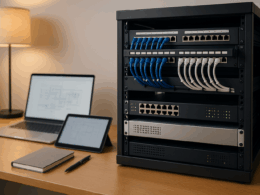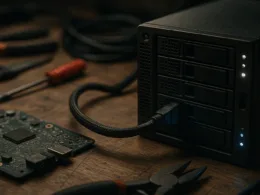Introduction
Cyber espionage isn’t just the stuff of James Bond films; it’s a grim reality that impacts both governmental and corporate entities worldwide. As the world becomes more interconnected, the tactics employed by cyber espionage groups evolve, leaving a trail of data breaches and security nightmares. If you think your data is safe, think again—those stealthy operatives are probably lurking in the shadows, waiting for a moment of weakness.
In this article, we’ll delve into the tactics employed by prominent Middle Eastern cyber espionage groups such as Stealth Falcon and Horus. With a little understanding of their methods, we might just be able to outsmart these digital intruders.
The Rise of State-Sponsored Cyber Espionage
The rise of state-sponsored cyber espionage can largely be attributed to geopolitical tensions. Nations are increasingly leveraging cyber capabilities as a means of gaining intelligence and undermining adversaries. For example, groups like UNC1860, which is tied to Iran’s Ministry of Intelligence and Security, exemplify how these actors operate.
Utilising sophisticated tools such as TEMPLEPLAY and VIROGREEN, UNC1860 sneaks into government networks, often exploiting vulnerabilities in internet-facing servers. Their ability to adapt their techniques based on geopolitical shifts is noteworthy and a crucial part of their modus operandi. In essence, as tensions rise, so does their activity, making them formidable adversaries in the cyber realm.
Spotlight on Stealth Falcon and Horus
Stealth Falcon’s Approach
Stealth Falcon is an APT group notorious for its targeted attacks, primarily on government and defence sectors across the Middle East and Africa. Through spear-phishing methods, they’ve managed to compromise security with alarming success. A recent campaign showcased their exploit of a zero-day vulnerability (CVE-2025-33053), which allowed them to execute malware using specially crafted URLs.
The phishing operation begins with an innocuous-looking email leading to a malicious .url file, tricking users into granting access to their systems. From there, they deploy multi-stage infections that include clever tricks such as keyloggers and credential dumpers—tools that steal sensitive data—by manipulating legitimate tools.
The tale here isn’t just one of deception; it’s laced with a touch of sophistication and stealth. Stealth Falcon’s use of seemingly innocent domains masks their true intent, making detection a difficult and often elusive task.
Understanding the Horus Agent
Horus is another tool in the cyber espionage arsenal, commonly linked with the activities of groups like Stealth Falcon. Built on the Mythic open-source framework, Horus incorporates anti-analysis techniques designed to avoid detection. It serves as a perfect example of how modern cyber tools blend complex functionalities with a simple user interface—making it more appealing for less tech-savvy attackers as well.
Breaking down the components of Horus reveals a concerning reality: these aren’t just scripts written in a basement somewhere; these are functional frameworks built to withstand detection and targeted specifically toward sectors that hold valuable data.
Common Myths Surrounding Cyber Espionage
Cyber espionage is frequently shrouded in myths that can muddle the understanding of its real implications. Let’s break down a few:
- Myth 1: It Only Affects Large Corporations: While high-profile targets make headlines, small businesses aren’t immune. They are often viewed as soft targets with fewer resources to defend against attacks.
- Myth 2: Cyber Espionage is Obsolete: In reality, it’s growing. The methods employed are getting more sophisticated, hence constant vigilance is necessary.
- Myth 3: Cybersecurity is Just IT’s Problem: It’s everyone’s issue. Ensuring company-wide practices can help stem the tide of potential breaches.
- Myth 4: Antivirus Software is Enough: Modern attacks can bypass traditional antivirus measures, using stealthy approaches that require layers of defence.
- Myth 5: I’m Not a Target: If you have data, you’re a target. It’s just a matter of time.
Addressing Vulnerabilities and Enhancing Security
Given the reality of these threats, how can one bolster their cyber defense? Here are a handful of strategies:
- Regular Training: Equip all staff with knowledge about phishing and social engineering tactics. Everyone is on the frontline.
- Implement Multi-Factor Authentication (MFA): This adds layers of security and can significantly reduce the likelihood of unauthorised access.
- Conduct Regular Vulnerability Assessments: Identifying weaknesses before attackers can exploit them is crucial.
- Use Advanced Threat Detection Tools: Platforms like IronNet can help track and neutralise threats more effectively.
- Stay Updated on Cyber Threats: Ensure your systems and employees are aware of the latest tactics and vulnerabilities in use.
Final Thoughts
Navigating the murky waters of cyber espionage requires a keen understanding of the ever-evolving tactics employed by groups like Stealth Falcon and Horus. While the threat is persistent, the power to mitigate it lies within informed actions and proactive measures. Ignoring these realities is like swimming with sharks and hoping they don’t bite.
By making cybersecurity a collective responsibility, enhancing awareness, and deploying robust security practices, we can fortify our digital shores against these stealthy intruders. It won’t eliminate the threat entirely, but it’s a solid step towards mitigating risks that could otherwise lead to significant breaches.










